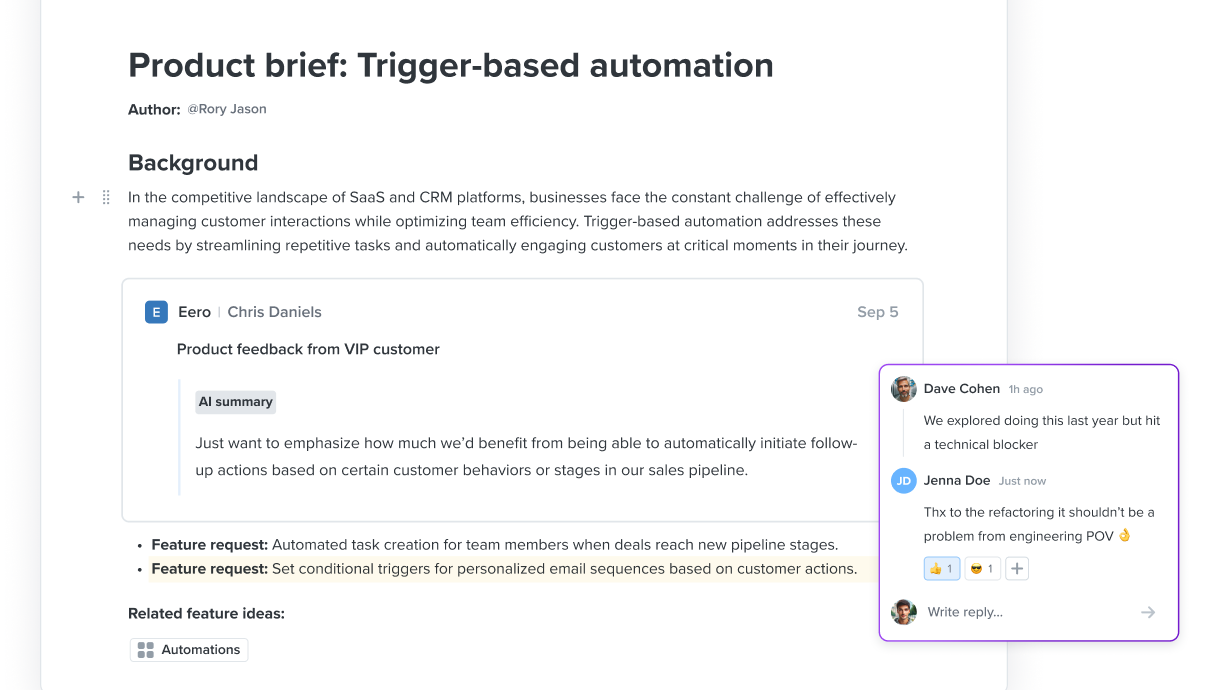The secret to a potent and practical product strategy—lessons from growing Zendesk to $700m

Clear product strategy might be but one of the three pillars of Product Excellence—but it’s the one companies struggle with most often.
Think of your product strategy as a high-level plan for keeping your team aligned and working on the right things. Without a high-level product strategy closely tied to overarching business goals, product leaders run the risk of wasting development resources, launching the wrong products and features, and losing the faith of customers and stakeholders alike.
Sam Boonin isn’t one of those leaders.
With over 20 years’ experience driving strategic product teams in software companies, Sam is a seasoned product strategist and team builder. During his 8-year stint as VP of Product at Zendesk, Sam grew the product team from 5 to 75 people, helping propel the company from $15m in annual revenue to over $700m at the end of his tenure.

That level of growth is nigh-impossible unless everyone at the company has full clarity around where the company is headed and why—clarity that many companies struggle to create, but, according to Sam, is easier than many realize.
We convinced Sam to take a break from his advising work with Productboard and share with us the three best practices of an effective product strategy.
Galvanize customers & stakeholders around a unified product vision—a North Star
Product managers are no strangers to competing priorities and demanding stakeholders. “Whether they want a feature that’s going to help a particular customer pay you more money or something they’re just personally passionate about, everybody wants something out of the product roadmap,” Sam explains.
Without a clear and overarching vision for the product, teams end up mired in a reactive mindset—swinging from one feature to the next instead of creating clear priorities, fighting endless battles with technical debt instead of building valuable features, and going tit for tat with competitors instead of defining clear objectives.
The problem? Building coherence and alignment around priorities isn’t easy—especially in fast-growing tech companies like Zendesk.
One of the best ways to align your team around a cohesive vision of the future is to create what Sam calls a North Star, or vision statement—a guiding idea or vision that articulates the problem the company is working to solve, along with a tangible end state that acts as a guiding light for stakeholders and customers alike.
A vision statement is a guiding idea or vision that articulates the problem the company is working to solve, along with a tangible end state that acts as a guiding light for stakeholders and customers alike.
“We used to joke at Zendesk that our North Star was the thing we wanted to be when we grew up,” Sam jests. “Our ultimate goal was always that we wanted to be more than just customer support software. We knew that the world of customer experience was going to change forever—and we wanted to be a vendor that helped enable companies to transform their customer experiences.”
A carefully chosen North Star vision statement can span growth maturity levels and keep a company focused for many years. Zendesk’s North Star, for example, allowed Sam and the team to make product decisions based on where they wanted to be in 3-5 years instead of the usual 1-2 quarters.
“We had a strong point of view about what the end-user experience should look like. We could say, ‘Are people going to use Facebook and WhatsApp instead of email?’ ‘If someone’s in the middle of an immersive multiplayer game and it breaks, how are they going to reach out to a company for support?’”
Sam suggests creating your North Star alongside your product leadership team. Work together to describe your North Star vision in brief and compelling words. Describe the high-level problem you’re working to solve for your customers clearly and articulately. The more coherent your strategy, the easier it will be to build a shared understanding among team members, customers, and stakeholders.
Here’s a sample vision statement from Joel Spolsky to lay the groundwork for your own North Star:
For a mid-sized company’s marketing and sales departments who need basic CRM functionality, the CRM-Innovator is a Web-based service that provides sales tracking, lead generation, and sales representative support features that improve customer relationships at critical touch points. Unlike other services or package software products, our product provides very capable services at a moderate cost.
Sam also recommends product leaders make an effort to remind teams of their North Star at least weekly. The more invested team members are in your product vision, the easier it will be to keep everyone striving in the same direction. Every team member should be able to explain how the work they’re doing in that moment contributes to the bigger picture, and every customer should understand how that North Star impacts the product trajectory.
“Customers buy trajectories as much as they buy current features,” Sam explains. “They’re not just buying into the current product—they’re also buying into what the future of that product is going to look like.”

Make strategic investments in your product to reach your goals
Your North Star vision might explain where you want your product to go—but your product strategy explains how you’re going to get there.
An effective product strategy includes a clear statement of how companies will invest their time and resources across competing priorities. Just as financial investors balance their higher-risk short-term plays with more stable long-term investments, product leaders should strategically balance how much time they want to invest in creating innovative products, improving existing products, or simply keeping the lights on.
An effective product strategy includes a clear statement of how companies will invest their time and resources across competing priorities.
But without a shared understanding of how product teams should be spending their time as companies grow, Sam often sees product aspirations clashing with reality.
“I work with a lot of companies that are early in their development,” Sam explains. “The biggest problem I see is that everyone is reading blog posts or business books and comparing themselves to companies like Tesla or Uber—companies that aren’t in the same phase of growth that they’re in.”
Of course, your North Star should be ambitious enough that companies are forced to aim high—but those lofty goals need to be grounded in reality. When companies aspire to be something they’re not, they frequently fail to identify the optimal strategy for the growth phase they’re currently in.
That mismatch between reality and strategy leads product leaders to invest in features and updates that fail to move the needle—for example, spending time launching new products or features instead of improving those that customers already use and love.
“The biggest issue I see is that companies need a shared understanding of which phase they’re in.”
When Sam started at Zendesk, they were a traditional digital business. “Most of our sales came from our online business. A bunch of people came to our website, they would sign up for the product trial, and they would purchase online.”
While this strategy was sustainable at smaller sales volumes, the team knew that growing the business meant moving up-market—a shift that meant less time processing feedback from their existing early-adopter customers and more time spent on more traditional direct sales and customer success channels.
“Once we could align our strategy with our go-to-market motions, it became a lot easier to figure out what to invest in on the product side. In order to move upmarket, we needed to fix X, Y, and Z in the product. In order to protect our core business [of smaller customers], we needed to improve the product in these ways.”
The moral of the story? Stop comparing your product to other companies, and forge your own product investment strategy.
State clearly in your product strategy which growth stage your company is in, and write down a high-level plan for how you want your company and product to grow over the next 3-5 years. Then, you can assess whether your current product trajectory fits your chosen business goals, or whether you need to shift plans accordingly.
Finally, write down clear targets for how much time they want to invest in creating innovative products, improving existing products, or simply keeping the lights on. “Even if you don’t track it,” Sam mentions, “the process of writing it down helps you combat short-term focus and keeps the team aligned.”

Adopt long-term strategic goals to avoid relying too heavily on short-term metrics
Strategy tends to have a longer time horizon than other product-related work. “Roadmaps generally only focus one to four quarters out, whereas strategies tend to look at a longer lifespan,” Sam explains. “Strategies should think about beyond the next release or the next sprint—depending on the company and strategic maturity level, a product strategy would typically look out 1-3 years out with some intentional structure and investment thesis.”
The only difficulty? The longer companies look into the future, the more uncertainty they encounter around customer needs, stakeholder priorities, and product trajectory. In an effort to combat that uncertainty, many companies seek out alternative planning tools like OKRs (Objectives and Key Results) that provide product leaders more confidence.
OKRs are handy because they’re measurable—things like increasing trial conversions by 25%, growing ARPA by 15%, or winning 20 new enterprise deals. “The theory of OKRs,” according to Sam, “is that you not only set the objectives, but that the key results are tracked on a regular basis and you can instrument the entire company to make sure you’re making progress towards them.”
Unfortunately, the quantitative nature of OKRs instills a false sense of confidence, particularly among inexperienced product leaders. Sam regularly sees teams “cargo culting”—adopting rituals and tools like OKRs that they’ve seen other successful companies using without fully understanding where that success stems from.
“Teams might have no idea what their overarching product strategy is, but they believe that if they just OKR everything up, magically prosperity is going to come to their company.”
But according to Sam, product leaders are doing their teams a disservice by over-relying on this metrics-driven approach. “Because you’re focused on those individual pillars rather than the big picture, the pendulum swings towards teams believing that achieving these tactical measurements alone will lead them to the actual goal,” he explains. An overreliance on short-term OKRs leads to very tactical decision-making, shortcutting the hard work required to build a successful product and running counter to intentional long-term strategic product investments.
Sam’s solution for avoiding the OKR trap? Adopt more qualitative longer-term goals.
“Product strategy is all about being intentional,” Sam explains. “Like any good investment strategy has a combination of short-term and long-term investments, any good product strategy should have a balance of short-term and long-term investments in the product.”
Sam suggests product teams adopt qualitative goals that span a longer time period—a quarter or a year. “By the end of next year,” he gives one example, “we should have a good enough product to support companies with a thousand users.” Strategic product goals should be sufficiently ambitious that they provide multiple avenues for success without dictating direction.
While qualitative goals might sound vague in comparison to quantitative objectives, that vagueness is intentional. Setting a more distant target allows team members to rally around an idea as opposed to more immediate metrics and OKRs, keeping the team galvanized on a unified goal.
The key to Product Excellence? A shared understanding of strategy
Great product strategy doesn’t happen overnight—and it certainly doesn’t spring fully-formed from the minds of your product team. Getting the right products to market faster—products that truly make a difference in users’ work and life—can only happen when the entire teams’ efforts are unified around a single objective. Only by creating a shared understanding of product strategy can you enable and empower your team to own their own missions and destinies—and create better products.
Sam’s final piece of advice for product leaders looking to empower their teams and achieve Product Excellence? Write everything down, and share it with your team at every opportunity.
“Step away from the roadmaps and mockups, and go through the process of writing your strategy down on paper in long-form—like a high-school essay,” Sam recommends. “You’ll discover whether you have a long-term strategy—one that isn’t based on hallway conversations or sprint reviews—and you’ll discover whether or not you’re aligned on that strategy.”
After all, Sam sums it up well: “There’s power in the narrative.”





